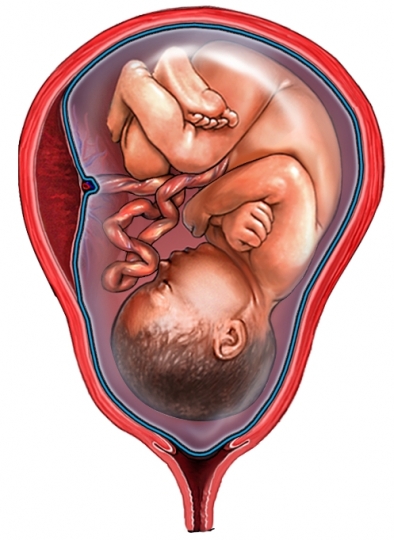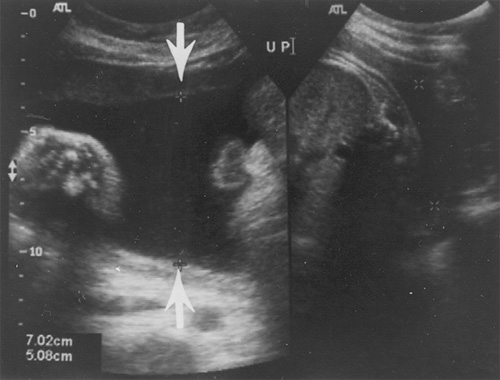Adequate amount of amniotic fluid allows for the growth and movement of the fetus and offers support to umbilical cord and fetus. Oligohydramnios can, therefore, lead to umbilical cord compression, fetal deformation and even death.
What is the oligohydramnios definition? How is this condition diagnosed? Usually, your doctor will do an ultrasound examination. Results are usually given quantitatively (amniotic fluid index≤5) or qualitatively (reduced or normal).
Oligohydramnios Definition
Oligohydramnios refers to the condition that there is inadequate fluid in the amniotic sac of the expectant mother. The amniotic sac is a water bag found in the uterus that keeps the baby cushioned and protected, allowing for normal growth and development. The normal levels of amniotic fluid vary from person to person. On average, an expectant mother should have about 1 liter at the 36 to 37 weeks of pregnancy. Oligohydramnios are usually an indication that there is a problem with the baby or the mother. The condition can cause certain problems depending on when it occurs during the pregnancy.
 First Half of Pregnancy
First Half of Pregnancy
- High miscarriage risk
- Impaired lung development
- Birth defects as a result of compression of the baby
Second Half of Pregnancy
- Preterm birth
- Baby experiences reduced growth
- High chances of fetal distress during labor. This often necessitates cesarean section.
Images of Oligohydramnios Condition
With images, you can better understand the oligohydramnios definition. Here are 3 images of this condition.
Normale fluid image: the image below shows a 30-week gestion with a singal deepest pocket of amniotic fluid of 7 cm, which refers to a normal amniotic fluid volum.

Image 1: Here is an ultrasound taken at 20 weeks showing the absence of amniotic fluid—oligohydramnios due to the bilateral renal agenesis.

Image 2: The four quadrants image of amniotic fluid index reveals severe oligohydramnios.

Image 3: This is a 19 week fetus showing signs of Turner's syndrome, oligohydramnios and cystic hygroma (shown by the arrows)

What Can Cause Oligohydramnios?
From the oligohydramnios definition, it is clear that the condition is caused by several factors. It is sometimes hard to pinpoint the exact cause of the condition. Some of the causes include:
- Development problems in the baby, for example, complications with the urinary system of the fetus
- Birth defects
- Placenta complications
- Amniotic sac tears
- Pregnancy continues way past the due date
- Medical conditions in the mother such as diabetes, dehydration or high blood pressure
- Complications caused by certain medications
How to Diagnose Oligohydramnios
Aside from the oligohydramnios definition and causes, you will naturally want to know how this condition is diagnosed. Usually, the doctor will first ask about your medical history and the symptoms you're exhibiting. Then, a physical exam will be done, followed by an ultrasound to view the fetus and uterus.
A measurement of fluid levels will also be taken. The doctor will examine the fetus for any signs of complications. S/he might also opt to do a blood test and other tests to confirm that there are no health conditions in the mother and the fetus.
How to Treat Oligohydramnios
Treatment of oligohydramnios will largely depend on the gestational age. If the mother has not reached full term, the doctor will closely monitor both the baby and the mother. The baby might be monitored using tests like contraction stress and non-stress tests. Should the mother be close to full term, then the doctor will usually recommend a delivery.
Other Treatments
- Amino-infusion through an intrauterine catheter during labor. The additional fluid helps with better support to the umbilical cord and lowering the chances of cesarean delivery.
- Maternal rehydration with IV fluids or oral fluids can help increase the levels of amniotic fluid.
- Fluid can be injected through amniocentesis before delivery. While the condition could return about a week after the procedure has been done, it helps doctors visualize fetal anatomy for an easier to diagnosis.
Tips to Prevent Oligohydramnios
There is only one way to prevent oligohydramnios – treating the cause whenever possible. From the oligohydramnios definition, you can see that it has a number of causes and risk factors. Tackling these conditions as they arise is the only surefire way of preventing oligohydramnios. It is also important for a mother to get proper care during, before and after pregnancy. This could include:
- Consulting your doctor on any supplements, medications and herbal treatments you are using before getting pregnant.
- Getting regular checkups all through pregnancy.
- Living healthy – eat a balanced diet, take enough water and get adequate rest. Take vitamin supplements whenever necessary.
- Appoint regular screening tests.
